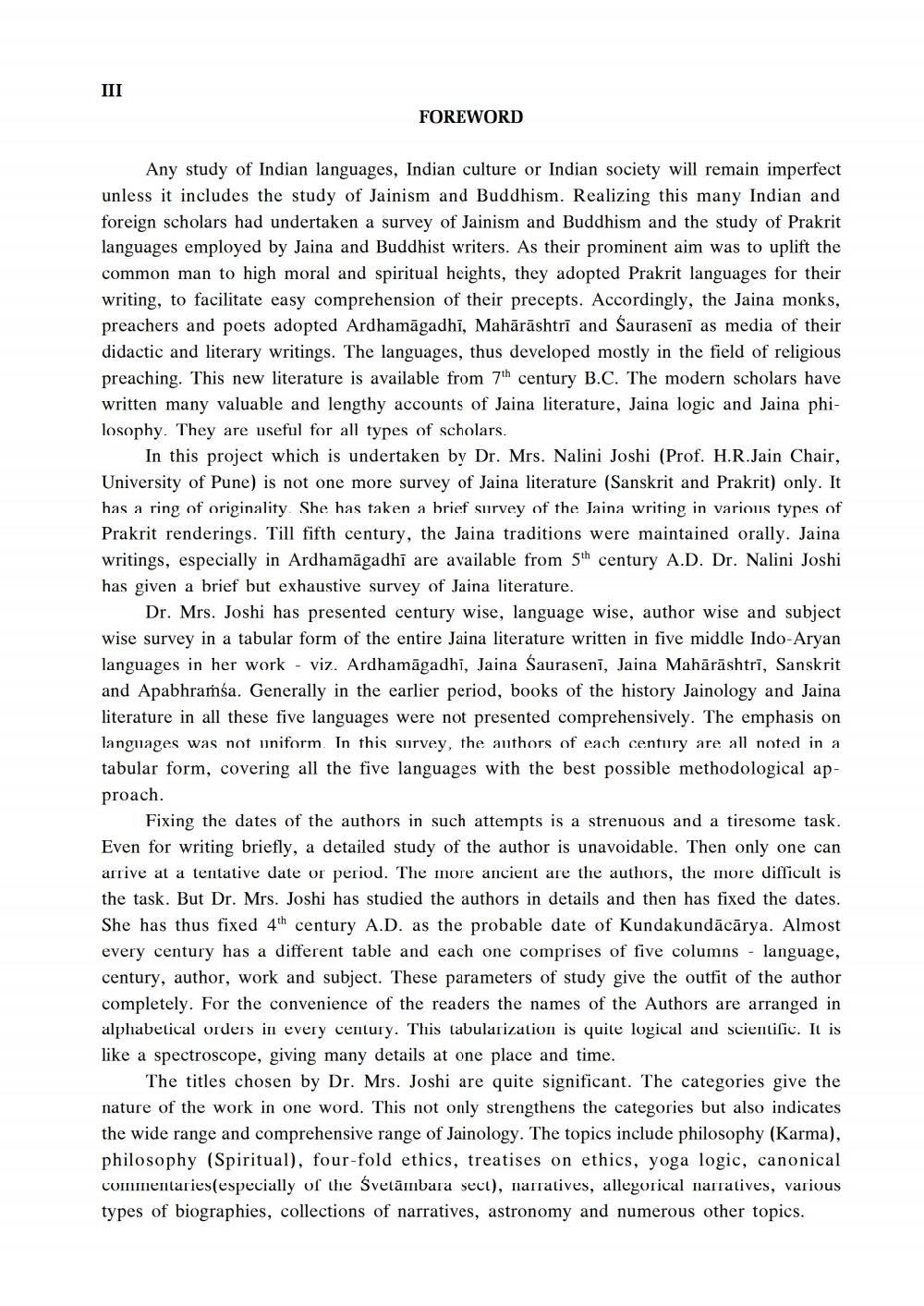Book Title: Brief Survey of Jaina Prakrit and Sanskrit Literature Part 1 Author(s): Nalini Joshi Publisher: Sanmati Tirth Prakashan Pune View full book textPage 4
________________ III FOREWORD Any study of Indian languages, Indian culture or Indian society will remain imperfect unless it includes the study of Jainism and Buddhism. Realizing this many Indian and foreign scholars had undertaken a survey of Jainism and Buddhism and the study of Prakrit languages employed by Jaina and Buddhist writers. As their prominent aim was to uplift the common man to high moral and spiritual heights, they adopted Prakrit languages for their writing, to facilitate easy comprehension of their precepts. Accordingly, the Jaina monks, preachers and poets adopted Ardhamāgadhi, Mahārāshtrī and Sauraseni as media of their didactic and literary writings. The languages, thus developed mostly in the field of religious preaching. This new literature is available from 7th century B.C. The modern scholars have written many valuable and lengthy accounts of Jaina literature, Jaina logic and Jaina philosophy. They are useful for all types of scholars. In this project which is undertaken by Dr. Mrs. Nalini Joshi (Prof. H.R.Jain Chair, University of Pune) is not one more survey of Jaina literature (Sanskrit and Prakrit) only. It has a ring of originality. She has taken a brief survey of the Jaina writing in various types of Prakrit renderings. Till fifth century, the Jaina traditions were maintained orally. Jaina writings, especially in Ardhamāgadhi are available from 5th century A.D. Dr. Nalini Joshi has given a brief but exhaustive survey of Jaina literature. Dr. Mrs. Joshi has presented century wise, language wise, author wise and subject wise survey in a tabular form of the entire Jaina literature written in five middle Indo-Aryan languages in her work - viz. Ardhamāgadhi, Jaina Saurasenī, Jaina Mahārāshtrī, Sanskrit and Apabhramsa. Generally in the earlier period, books of the history Jainology and Jaina literature in all these five languages were not presented comprehensively. The emphasis on languages was not uniform. In this survey, the authors of each century are all noted in a tabular form, covering all the five languages with the best possible methodological approach. Fixing the dates of the authors in such attempts is a strenuous and a tiresome task. Even for writing briefly, a detailed study of the author is unavoidable. Then only one can arrive at a tentative date or period. The more ancient are the authors, the more difficult is the task. But Dr. Mrs. Joshi has studied the authors in details and then has fixed the dates. She has thus fixed 4th century A.D. as the probable date of Kundakundācārya. Almost every century has a different table and each one comprises of five columns - language, century, author, work and subject. These parameters of study give the outfit of the author completely. For the convenience of the readers the names of the Authors are arranged in alphabetical orders in every century. This tabularization is quite logical and scientific. It is like a spectroscope, giving many details at one place and time. The titles chosen by Dr. Mrs. Joshi are quite significant. The categories give the nature of the work in one word. This not only strengthens the categories but also indicates the wide range and comprehensive range of Jainology. The topics include philosophy (Karma), philosophy (Spiritual), four-fold ethics, treatises on ethics, yoga logic, canonical commentaries(especially of the Svetāmbara sect), narratives, allegorical narratives, various types of biographies, collections of narratives, astronomy and numerous other topics.Page Navigation
1 2 3 4 5 6 7 8 9 10 11 12 13 14 15 16 17 18 19 20 21 22
